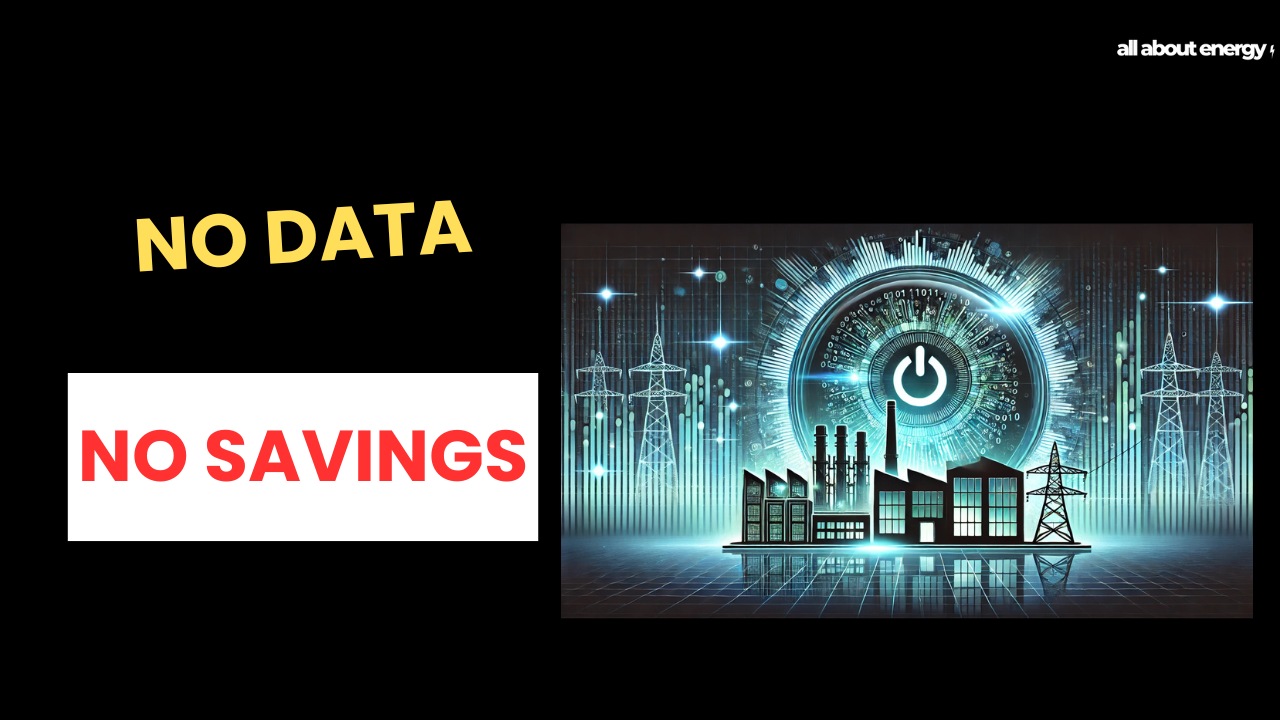Why Data Drives Every Energy Decision
Written by Joe Wright
Every energy-saving initiative, from reducing consumption to integrating renewable energy, depends on understanding your current situation. And that understanding can only come from robust, accurate, and actionable data. Without it, your efforts amount to little more than guesswork—and guesswork rarely pays off.
But what does “data” truly mean in the context of energy management? Let’s break it down.
1. Energy Consumption
- Why it’s crucial: If you don’t know how much energy you’re using, how can you reduce it? Tracking consumption over time provides a baseline to measure progress and identify areas for improvement.
- What to monitor: Daily, weekly, and seasonal usage patterns, as well as historical trends, to detect anomalies or inefficiencies. You would also benefit from half-hourly data analysis. Review this data with operational schedules to determine if energy use aligns with productive activity or if there are inefficiencies, such as equipment running unnecessarily out of hours.
2. Energy Costs
- Why it’s crucial: Understanding how and when you’re charged for energy can reveal opportunities for cost optimisation. You need to look beyond the headline cost figure
- What to look for: Unit rates, peak-time charges, capacity penalties: for example paying for unused capacity due to over estimations in the contract, and discrepancies in billing. For example, are you unknowingly paying higher rates during peak hours? A deeper analysis can uncover errors or opportunities for renegotiation.
3. Asset Information
- Why it’s crucial: Inefficient or outdated equipment can be a silent energy drain.
- What to track: A detailed asset list including age, run hours, load profiles and efficiency ratings. This allows you to target upgrades or replacements where they’ll have the most impact.
4. Building Data
- Why it’s crucial: Your facility’s structure directly influences energy use.
- What to know: Insulation levels, ventilation systems, and heating and cooling requirements. Retrofitting and structural upgrades are impossible without understanding your building’s energy profile.
5. Operational Profiles
- Why it’s crucial: Aligning energy use with operational demand is key to efficiency.
- What to assess: Business hours, staffing levels, and process schedules. For example, could energy-intensive tasks be shifted to off-peak times to save money?
6. Maintenance Records
- Why it’s crucial: Poor maintenance can lead to inefficiencies and higher energy costs.
- What to include: Maintenance schedules and logs. Ensuring timely servicing prevents unnecessary downtime and energy waste. Questions to ask include:
- Are certain assets consuming more energy over time?
- Could predictive maintenance reduce down time?
- Which standards are your maintenance schedules aligned to?
7. Strategic Plans
- Why it’s crucial: Your energy strategy must align with broader business objectives.
- What to integrate: Plans for expansion, equipment upgrades, or changes in production schedules.
- Ask yourself
- Are you incorporating energy-efficient technologies into capital expenditure plans?
- How do your initiatives support broader objectives like achieving net zero?
This ensure that your energy initiatives are future-proof.
What Happens Without Accurate Data?
If you’re missing data or relying on incomplete information, you could be setting your organisation up for failure. Here’s why:
1. Energy Cost Reduction Initiatives Fail
You may invest in solutions that address the wrong problem or fail to deliver significant savings. For example, upgrading lighting without addressing heating inefficiencies might yield minimal results while tying up capital.
2. Compliance Risks
Mandatory schemes like ESOS or SECR require detailed reporting. Missing or incorrect data can lead to non-compliance, resulting in fines and reputational damage. Worse, it signals to stakeholders that your energy management is disorganised.
3. Missed Opportunities
Without a clear picture, you might overlook simple, high-impact fixes. Comprehensive data helps pinpoint the changes that will deliver the greatest return on investment.
How to Use Data Effectively
Harnessing the power of data involves more than just collecting it. You need systems and strategies to turn raw data into actionable insights.
1. Adopt Energy Management Software
Platforms that integrate data from multiple sources—utility meters, IoT sensors, and operational systems—offer a holistic view of your energy performance.
2. Real-Time Monitoring
IoT devices provide continuous updates, enabling you to identify and address inefficiencies as they occur. For example, real-time data can alert you to equipment running unnecessarily outside business hours.
3. Data Analysis Tools
Analytics tools help you make sense of the numbers, highlighting trends, inefficiencies, and areas for improvement. Dashboards and visualisation tools can make complex data accessible to all stakeholders.
4. Collaborative Effort
Data isn’t just the responsibility of your energy manager. Finance, operations, and strategy teams all have a role to play. Sharing insights across departments fosters a culture of accountability and collaboration.
How Data Drives Success
By leveraging comprehensive data, organisations can:
- Identify Savings Opportunities: See exactly where energy is being wasted and take targeted action to reduce costs.
- Justify Investments: With data to back you up, it’s easier to make the case for energy-efficient technologies or infrastructure upgrades.
- Achieve Net Zero Goals: Robust data enables you to measure, monitor, and reduce your carbon footprint effectively.
The Bottom Line
Data is the foundation of every successful energy strategy. Without it, your organisation risks inefficiency, non-compliance, and missed opportunities. The question isn’t whether you need better data—it’s how quickly can you start collecting, analysing, and using it to inform decisions.
Taking control of your energy data is the first step toward cost savings, compliance, and a sustainable future. What are you waiting for? It’s time to start.
FAQs
1. What tools are best for energy data collection?
Energy management software and IoT sensors are essential for real-time monitoring and comprehensive data collection.
2. How often should I review my energy data?
At least monthly, though real-time monitoring provides the most actionable insights.
3. Can small businesses benefit from energy data management?
Absolutely! Small changes based on data-driven decisions can lead to significant cost savings.
4. How does energy data help with net zero goals?
Data allows you to measure and monitor your carbon footprint, identify reduction opportunities, and track progress toward your goals.
5. Is investing in energy management systems expensive?
While there’s an upfront cost, the savings and efficiency gains typically deliver a strong return on investment.
Watch the video for a quick overview of this topic:
Are you looking to improve your organisations energy management practices?
Take our Energy Management Scorecard quiz to assess your current strategies and identify areas for improvement. Click below for the free assessment

You May Also Like…
Compliance Simplified
If you’re part of any of the mandatory compliance scheme like SECR, ESOS, or the many others out there, then you...
Why maintenance matters for energy management
When you think about improving your energy management, where does your mind go first? Upgrades? New systems? Cutting...
Creating A Culture Of Energy Efficiency
If your business is subject to compliance schemes like ESOS or SECR, you’re not alone. A lot of the companies I work...




